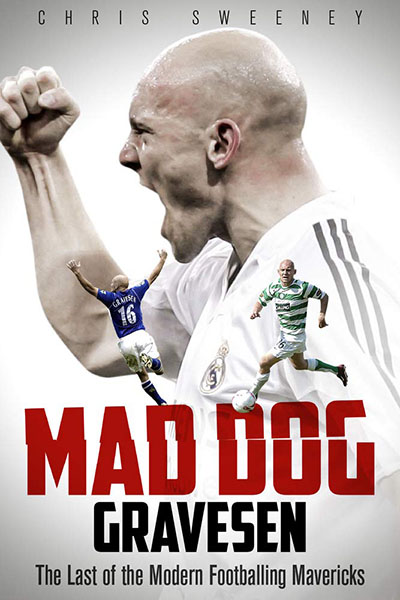
Pitch Publishing, £19.99
Reviewed by Paul McParlan
From WSC 391, October 2019
Buy the book
It is still an iconic look. The wild eyes, the snarling face, the shaved skull and the raised fist were the trademark images of Thomas Gravesen, whose star shone brightly but briefly in the first decade of this century; a player highly regarded in his native Denmark but one who apparently drove some managers and team-mates to distraction.
It appears that Gravesen’s life was as manic as his demeanour on the pitch. When with Hamburg, he would often travel back and forth on his motorbike to his home in Denmark at speeds of over 150mph, without anybody being aware. He bought 14 different cars in four years but mostly drove a Nissan Micra. Even Mike Tyson was desperate to meet him after watching him play for Denmark. When he split with his childhood sweetheart, his next girlfriend was a porn star from Playboy TV. After disappearing to the US, he re-emerged with considerable wealth that may have been accumulated via gambling, gaming or astute investments.
During training, he would grapple and bear-hug team-mates, throwing them to the floor with or without their consent. He thought nothing of wiping out one of his own players with a tackle in a practice match, which Robinho discovered to his cost at Real Madrid. At times, he completely ignored his manager’s instructions and appeared to play his own game.
The author, Chris Sweeney, admits to being fascinated with a footballer who journeyed from a small-town team in Denmark to playing in the Galacticos side at Real alongside David Beckham and Zinedine Zidane. Yet from such a pinnacle, within three years he couldn’t find a club, retiring aged 32. It was some reversal of fortune.
Gravesen is portrayed as a “throwback”, whose individuality survived because those qualities were never coached out of him. It is a fascinating argument which appears throughout the book. Is the academy system designed to produce conformists rather than characters? Is it better to harness the individuality of the “maverick” for the good of the team, rather than have them fit a rigid style of playing? Sweeney maintains that managers such as David Moyes at Everton achieved results by having their teams play to Gravesen’s strengths, whereas the likes of Gordon Strachan and Fabio Capello constantly tried to restrict his individuality and blunted his impact.
Gravesen achieved his most notable success with Everton as they finished fourth in 2004-05, resulting in an unexpected move to Real Madrid. His time in Spain was reasonably successful but when disciplinarian Capello arrived, his days were numbered. Celtic made him the highest-paid player in Scotland, but Strachan never knew how to deal with the Dane. It was a waste of money and talent, with Gravesen eventually banished to the reserves. Despite receiving offers in August 2008, he walked away from the game.
As the author admits, the book would have been better with the player’s involvement. Some insight from close friends and family would have been useful. We never really understand what motivated him. Nevertheless, this is an intriguing story, posing questions about the role of the “maverick” in modern football. Undoubtedly Thomas Gravesen never fulfilled his potential, but was he really to blame? You can draw your own conclusions.